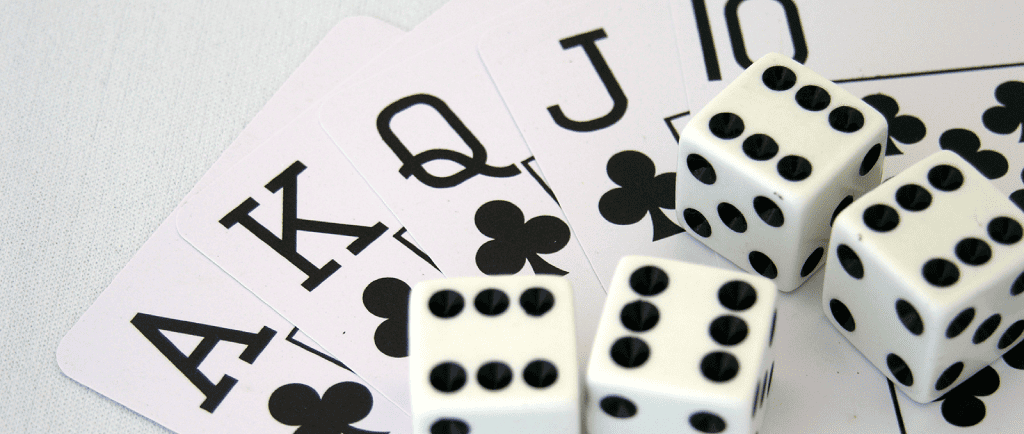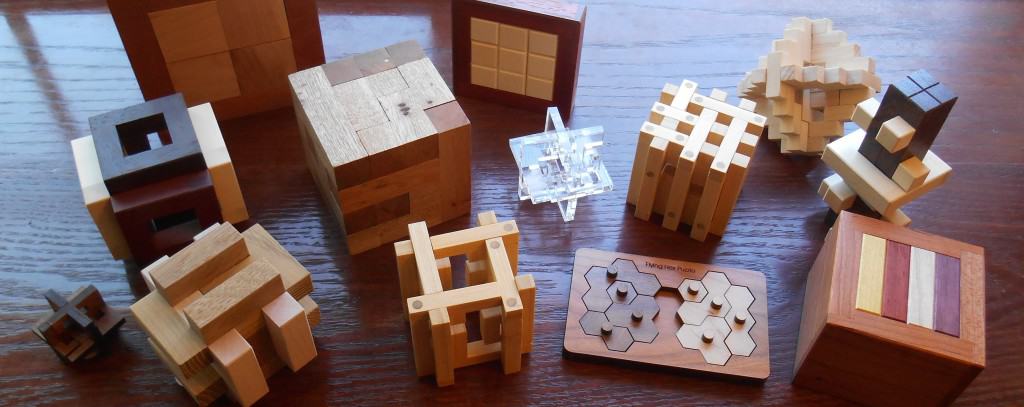
Many of you know that my other big hobby interest is mechanical puzzles, usually wooden monstrosities that take hours to put together. I design most of these with the aid of a software program called BurrTools, which takes a defined set of pieces and tells you how many sliding orthogonal moves it takes to remove a piece from the assembly. I’ve made of few of them myself, but generally, some wood craftsman like Eric Fuller of Cubic Dissection or Brian Menold of Wood Wonders offers to make copies for sale. I usually keep puzzle design and game design separate, but the design process for one does tend to overlap the other, and puzzle ideas can often be used to design games.
In the gaming industry, there is a fairly decent market for puzzle designs. Anyone who has ever bought a puzzle from ThinkFun knows this; their entire business model is wrapped around 3D and tray-puzzles, often with a deck of puzzle-cards providing harder challenges as you work your way through the deck. Rush Hour was one of their early successes. Gravity Maze and Tipover are two of their more recent successes. The “progressive difficulty” design is one of their regular features, and players enjoy it.
Still, one might consider puzzles a bit of a solitaire game, as Rush Hour is. You solve puzzles by yourself. Not exactly something you pull out on game night, is it?
Except, of course, savvy game designers have figured out interesting ways to incorporate puzzle-solving into board games. Yes, even Rush Hour has morphed into Rush Hour Shift, a 2 player game. Even Sudoku is available as a multiplayer game (online and offline).
So if you have a great idea for a puzzle, there are almost always ways to translate this into a board game. In a way, all games are puzzles; you are trying to optimize your resources in a limited rule structure faster or more efficiently than the other players. It’s just a puzzle with so many rules to follow that it no longer looks like a puzzle, it starts looking like life. But some games are much more obvious about their puzzle foundations, where it’s evident that the game is mostly just a multi-player puzzle. Let’s take a quick review of a few puzzle-based board games to see their common structures; it might give you some ideas on how to translate your puzzle idea into a playable game.
RICOCHET ROBOT (ALEX RANDOLPH)
The first time I set my eyes on this game, it looked boring; a half-dozen people sitting around a table staring at a nearly-empty board, a few little plastic robots sitting forlornly on the grid. Little did I realize the mental energy being expended, players mentally mapping out a solution to the potential maze of interactions required to move one robot from its starting location to its goal, blocked or aided by other robots. The first player to see a solution calls out a number of moves, then other players get 1 minute to find a better solution. The shortest number of moves to get to the goal wins the point for the turn. It’s a multiplayer puzzle. The puzzle is well defined and changes each turn, almost infinitely variable in its permutations. I consider this the best and most unique puzzle-solving game out there.
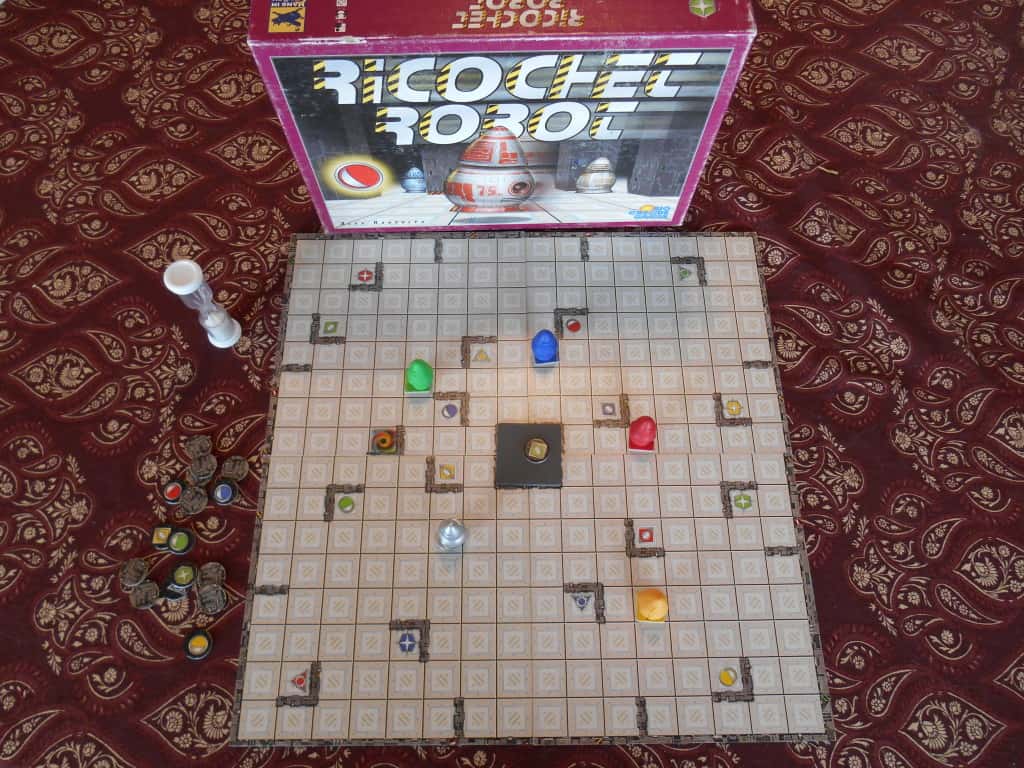
TANGOES, TURBO TAXI, SQUARE OFF
Tangoes is just multiplayer tangrams, a Chinese puzzle hundreds of years old. Each player has a nice set of plastic tangrams and a shape-card is turned up. Players race to solve the puzzle. In Turbo Taxi, each player has a set of 12 identical square tiles with winding streets on them, and race to place them on their own 3×3 board such that they connect the same 4 entry/exit points at the edge of the grid (two yellow and two black). In Square-Off, each player has the same entry/exit points on a board and they both try to slide tiles around (very quickly!) to make a complete path from entry to exit (which changes each round).
In many ways, these puzzle-games are only multiplayer solitaire; each player is trying to solve the same puzzle as fast as possible with their own board or tile set. The main difference between these and Ricochet Robot is that all players use a common puzzle set in Ricochet Robot, thus reducing production cost. In most puzzle-games, the object, above all, is to solve a common puzzle faster than someone else can solve it.
SET
One of the best pattern-finding games available. Twelve cards are dealt out in a 3×4 grid. Each card represents 4 characteristics; quantity, color, shape, and internal filling of the shapes. For each characteristic, there are 3 varieties. So you can have 1, 2, or 3 shapes on a card, they can be blue, red, or green, they can be squiggles, bars, or diamonds, and they can be empty, striped, or solid. Your goal is to find a set of 3 cards in which each characteristic is all the same, or all different. For example, you can find a SET in which all the cards are green, all the cards have 3 objects each, but all are different colors and all have different interiors. This is a great game for younger people, since they can pick it up fast and beat adults easily.
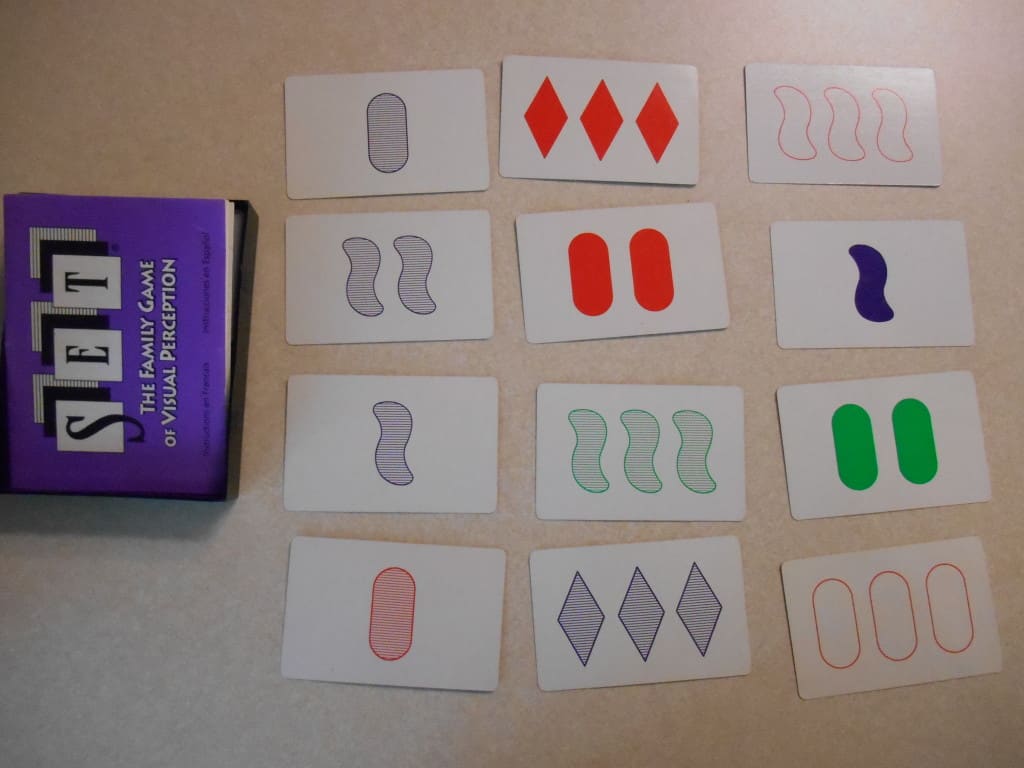
GOT IT!, KRYPTO, 24 GAME, MATH DICE
Each of these games have the same idea behind them; there is a goal-number, and you are to use the available numbers and math operators to reach that goal number. In Got It!, for example, all players examine a grid of 36 numbers and operators, and try to find a sequence of five cards (like 7-2×3, which you can bracket as you wish for a result of 15 or 1) to reach a goal (from 1 to 40). Great game for training young minds!
Note that in all the games listed so far, the foundation of the game is racing to find a solution to a single puzzle. This is the most common theme in puzzle-games and obviously the easiest to implement. You can take any solitaire puzzle, give a copy to two players, and say GO! Whoever solves it first wins the game! Even crossword puzzles, the epitome of single-player puzzles, are often used in multiplayer competitions. But there are other more subtle designs that fall under the category of logic puzzles. These don’t require speed, but favor the player who can logically derive the most information out of obscure hints acquired during play.
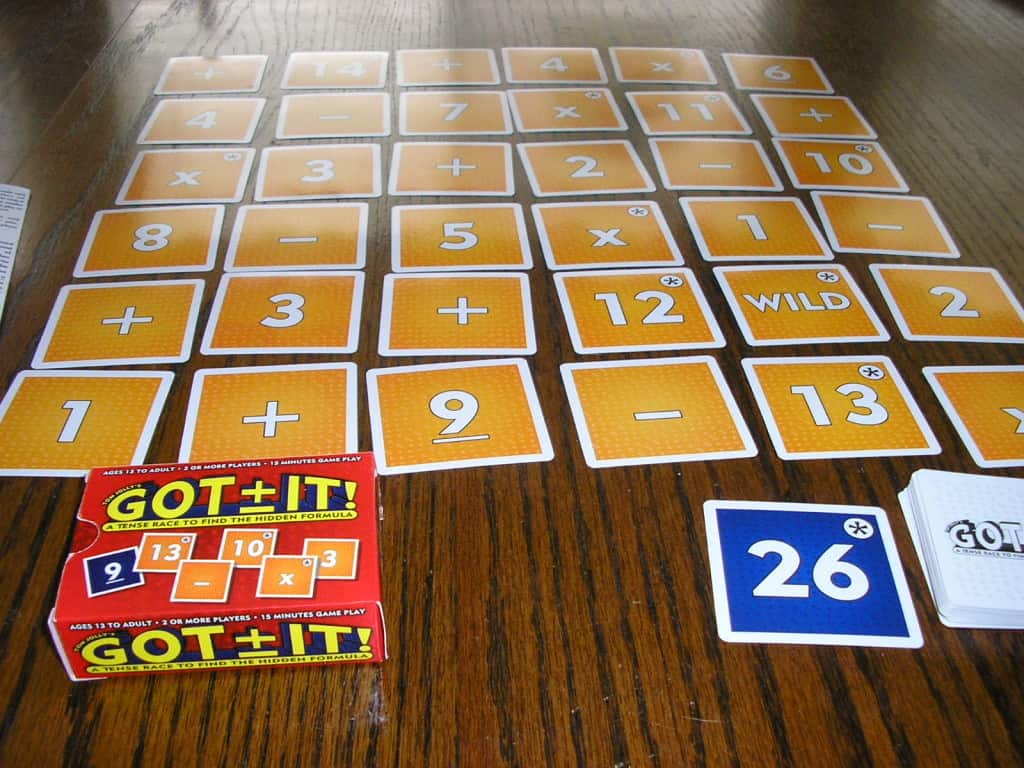
SLEUTH, CLUE, MYSTERY OF THE ABBEY
These are logic-puzzle games in which there is a hidden set of information that you must figure out based on clues you acquire during the game. Sleuth is a logic card game, a bit like Clue without the board, while Mystery of the Abbey has been described as Clue on steroids. It adds new event cards and special player abilities, and the rooms themselves have various effects on the game.
PATHFINDER (NOT THE CARD GAME OR RPG), BATTLESHIP, MASTERMIND
More logic-puzzle games. Each of these games requires one player to set up a hidden grid (a maze, a set of battleships, or a group of colored pegs) and the other player has to deduce by guesses what the layout of the maze or battleships or colored pegs is. They are all logical deduction games with the same goal, and as such, are extremely similar in play. They are also all 2-player games.
And then there are Pentomino based puzzles and their close relatives;
CATHEDRAL, UNIVERSE, L-GAME, BLOKUS
Cathedral and Universe are almost identical, in that you are playing pentominoes (or other –ominoes) on a board, from your own colored set, to limit the ability of the opponent to play his last one or two pieces in the remaining holes on the board. Blokus has a similar goal. The L-Game from Edward de Bono is a very cool little game with two L-shaped pieces and two neutral singletons on a 4×4 grid. The players take turns picking up their L and a singleton piece and putting them down wherever they can, until one player can’t play. Very unusual!
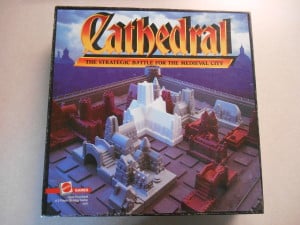
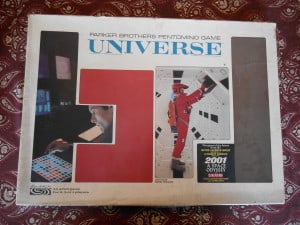
And other oddities;
ELEUSIS AND ZENDO
These are games where the object is to figure out the rules of the game using logical deduction. Eleusis was invented by Robert Abbott quite a while before Zendo, which is just a variation of Eleusis using Ice House pieces (from Looney Labs). But Eleusis uses a standard deck of cards (the rules are in a 1963 book called “Abbott’s New Card Games”, and were also published in Scientific American by Martin Gardner). Zendo uses a nice set of plastic pieces also used in the Ice House game. The object is that one player knows a hidden relational rule between pieces, and by displaying a sub-group of pieces, he gives a hint as to what that rule is. Other players then arrange sets of pieces to try to gather information about the rule, with the creator of the rule telling them, “Yes, that arrangement obeys the rule,” or “No, that doesn’t obey the rule.” For example, the rule could be, “Red pieces cannot rest on top of blue pieces.” A player puts a Green piece on top of a Red piece and asks the rulemaker if this obeys the rule. It does, of course. As you can imagine, it can take quite a while for any player to figure out even the simplest of rules. Eventually, instead of taking their normal turn, a player will venture to make a guess as to what the rule is. If he’s wrong, that’s just more information for the rest of the players. It’s an amusing party game of logical deduction that I always enjoy.
FITS, TAKE IT EASY.
Fits is, in essence, multiplayer Tetris (and a Knizia design), where each player has his/her own board, but they are all trying to play the same pieces. There is no time limit, however; these are both turn based, players vying for a high score. And there are, of course, a number of board games actually based on Tetris. Take It Easy also involves each player with his own board trying to play a common set of hexagonal pieces to maximize their own score in each row. These are interesting games, but quite low on player interaction, being essentially multiplayer solitaire as are many of the other puzzle games mentioned above.
Naturally, this is a somewhat superficially short list of available puzzle games. The Board Game Geek website lists 128 pages of puzzle-based games and expansions, so there’s a pretty wide variety of puzzle games available for the puzzlers in your family. Most of the ones that are listed here are listed because I’ve played them and enjoyed them at some time in my past.
There are obviously a lot of creative ways to incorporate puzzles into games. Games, by their nature, are merely very complicated puzzles that each player tries to solve to get an advantage. The more difficult a puzzle-game is to perfectly solve, where non-ideal solutions still garner points (as in Take It Easy), the more presentable it is to the general public. A puzzle with a perfect and accessible solution will nearly always be won by the one person most familiar with that solution algorithm (as with my brother when playing Krypto, or my niece with Set – both obnoxiously difficult to beat). This does not contribute positively to the playing experience of others in the game, or the sale at your con table if you trounce your customers. A fairly complicated set of rules that go beyond simple analysis (or even introduce luck elements) balance the playing field for the average player who’s there for the social interaction. It’s something to consider when you blend puzzles and games together.

